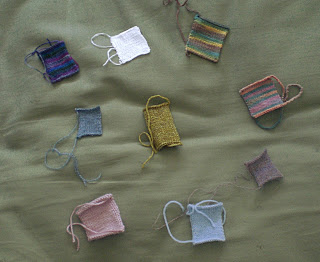A--Cotton
B--Wool
C--Alpaca
D--Tencel
E--Sugarcane
F--Silk
G--Silicon
H--Teflon
I--Bufallo
J-Soy/Milk
G (silicon) was dropped from the study. The manufacturer lists the brittle point at -62 C, and the polymer itself was difficult to work with and impractical for the end-game of this study (actually lashing things together).
Heat Transfer
Thermocouple data was nonparametric and therefore analyzed using a Kruskal-Wallis. Pairwise comparison was performed with a 2 sample Kolmogorov-Smirnov using Systat statistical software. Comparison of ranks yielded significant differences between groups (p <0.001) (Figure 1).
 | |
| Figure 2--Rate of temperature change of thermocouple when the swatch was plunged 1 cm into LN. The lowest mean temperature change +/- SEM belongs to E, I and J. |
| A | BDFHI |
| B | ACDEFHI |
| C | BDFHI |
| D | ABCEFHI |
| E | BDHIJ |
| F | ABCDHI |
| H | ABCDEGI |
| I | ABDEFGJ |
| J | EIJ |
Table 1--A comparison of differences between groups. Column one displays the group in question and column two lists the groups which are statistically no different from column one (KS, alpha = 0.05) I apologize for how crappy this looks, but apparently if you try to make a table in Blogger, you have permanently committed to having that table RIGHT THERE for all eternity. There is no way to display this easily graphically, unfortunately, as there are 3 fewer groups than variables. It gets ugly fast.
Stress Test
No swatches ripped, tore, or became glass-like when completely submerged in LN. All fabrics were able to curl, stretch vertically and horizontally, and twist 180 degrees without breaking. Swatches A and B became far stiffer when submerged than at room temperature. H froze in shape on the 180 degree twist and maintained the shape post thaw. Because A, B, and E are the only synthetic polymer containing fibers in this experiment and because all 3 changed their behavior under LN, it is my opinion that synthetic fibers, regardless of composition, are inferior to natural fibers. Of the natural fibers, plant fibers retained the most flexibility and behaved as though they were submerged in a room temperature water bath.
Discussion
In this experiment, I asked which fibers--both synthetic and natural--transfered the least heat while retaining their strength and flexibility in a LN environment. I found synthetics to be inferior to natural fibers in the stress test. The heat transfer experiment favored fibers with greater amounts of protein or synthetic makeups. Furthermore, animal and plant fibers were capable of drawing up LN using capillary action. Swatch J easily became completely saturated when only a small portion of the swatch was submerged. Because of this, I cannot recommend using plant or animal fibers for use between LN and non-LN conditions.Teflon, though, not ideal in terms of flexibility, would be best for this task. Cellulose and protein based fibers would be most useful completely submerged in or in close proximity to LN. They retain their strength and flexibility. Each fiber type has its strengths and weaknesses when placed in extreme conditions, and decisions regarding which fiber type to use where and when should be evaluated on an individual basis. There is no universal best fiber for use in LN, but experimental and technological design can and should exploit the strengths and weaknesses of each fiber's unique properties.
Limitations of this study
Because I was limited by available fibers and overhead costs, and because many fibers work best when spun particular ways, there is little uniformity among yarn weights. Ideally, all fibers would have been no denser than fingering weight. This discrepancy also made it difficult to determine the best method for working with the teflon and silicon (which did have a swatch knit), as those polymers were manufactered to an arbitrary appropriate thickness. However, given the consistent behavior of the fibers represented in multiple swatches, the discrepancy is most likely negligable. Any further research from this point should include fibers represented individually and in blends, spun to similar weights, and might include a wider variety of polymers.
Acknowledgements
I would like to thank Dr. Charles Herr and the CANBE lab, as well as the good people of Ravelry.com for their wisdom and insight while designing this experiment. It's been a blast.
---
And, without further ado, I present to you "lashing together two teflon containers, " featuring Buffalo Wool Company's "Moon Lite" and making use of my carefully honed 2nd grade level friendship bracelet skills. I ended up settling on the buffalo because it was only moderately absorptive when compared to other plant or animal fibers, and because of the strong tensile strength of the fiber. The rocking gold color doesn't hurt too much either. The other candidate was Kollage "Milky Whey," and that fiber was far more difficult to work with and potentially difficult to acquire if I ever required an additional hank.
When I presented my findings from this work to my boss, he was fascinated and as a result we've actually changed several protocols entirely to incorporate animal fibers. He doesn't think this experiment is "silly" any longer.
 |
| Ends have since been woven in. This is one of the components to a larger contraption which we'll try it out for the first time this upcoming Saturday. I am giddy with anticipation. |
 |
| Can we just pause for a moment and meditate on how undeniably gorgeous this yarn is? Because it is. Good gracious is this yarn beautiful. |

No comments:
Post a Comment